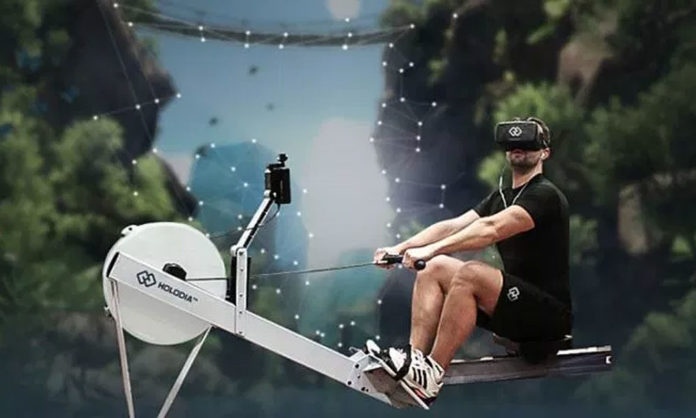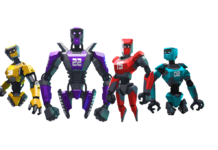Virtual reality fitness has continued to make great strides over recent months with exciting opportunities to integrate traditional fitness equipment into a virtual reality experience. This started with Virzoom’s VZfit which aimed to add gamification to stationary bikes allowing users to exercise and have fun at the same time. Check out my VZFit review if you’d like to know more. The industry has received another shot in the arm recently with the launch of Holodia’s Holofit software to the home consumer market.
Holodia is a Swiss-based company, who with three founders from France, Denmark and Serbia comprise a truly international team. Since 2018 they have been commercialized for business use in gyms and fitness centers with dedicated stations using tethered PC headsets. With the launch, last year of standalone mobile headsets such as the Oculus Quest the popularity of VR has increased substantially, and Holodia is tapping into that by adapting its commercial/business software for home consumer use.
Whereas Virzoom with its VZFit takes a very focused approach limiting compatibility to Oculus Quest or Go headsets only, and for use with a stationary bike, Holodia’s Holofit will work on all major PC VR and standalone mobile headsets and supports three classes of exercise equipment, the stationary bike, the elliptical machine, and the rowing machine. In this article, I’m going to cover the rowing experience.
I’ve been using the Holofit software with my Concept 2 Model E rowing machine for the past several weeks and feel ready to offer some detailed hands-on impressions, and I’ll follow this article up with a full fitness playtest review shortly. In this article, I’ll discuss my thoughts so far, how the Holofit software works, and its operation on use with a rower. I was also hoping to connect the Holofit to my bike using the sensor that came with Virzoom’s VZfit. Unfortunately, that sensor doesn’t use the standard cadence algorithm and isn’t compatible with the Holofit. Holodia recommends the IGPSport C61 cadence sensor for use with the Holofit and a stationary bike, which I have on order from eBay for around £16. I’ll cover how it performs on my bike in detail when it arrives.
I know many readers already familiar with Virzoom’s VZFit will be interested to see how the two products compare. I’ll touch on that in this hands-on but will go into much more detail in a future article once I’ve been able to test the Holofit with my bike.
This is quite a deep dive, so grab a coffee, and let’s explore Holodia’s Holofit…
Subscription service, but a generous license
With the controversial launch of the excellent but expensively priced Supernatural VR recently we’ve learned that consumers are not fans of subscription services. The Holofit has a subscription, but bear with me, as what you get for ten dollars a month is, in my opinion, really exceptional value.
First off, there are two product licenses. Holofit Pro, for PC VR headsets, and Holofit Go, for mobile headset use. You can purchase either by downloading a 7-day free trial from their website and then selecting what version you want. If you own both a mobile and a PC headset, however, you can email them and they will also give you the other license free of charge.
A single license enables you to use the Holofit with all compatible rowing machines, elliptical machines, and stationary bikes.
Best of all, the license supports up to five profiles allowing for other family members to have their own account with a single license fee.
This allows for such scenarios as you and your partner using the Holofit together on your stationary bike at home, connected to your PC for the best graphical experience, but then also being able to take your Oculus Quest to your local gym to use Holofit with their Concept 2 and elliptical machines, both using separate profiles and all for a single $9.99 a month fee.
They are constantly developing and updating the service too. In the month I’ve been using it a new race mode feature was added to the Quest version (PC update is on the way), and a couple of new environments to exercise through have been created as well. The new Online Multiplayer has also been launched last week, and they have already organized two live rowing competition events since. The Online Multiplayer allows real-time racing between HOLOFIT users on bicycles, rowers, or ellipticals; Holodia is planning to host further events and organize tournaments for their members.
Installation and Setup
Holodia boasts an extensive list of compatible headsets. All PC VR headsets are supported as well as the following mobile devices, Oculus Quest, HTC Vive Focus, and the Samsung Gear VR, although not the Oculus Go.
I have been using it on both my Oculus Quest and Oculus Rift S.
One consequence of trying to support as many headsets and exercise machines as possible is that the set up can be a little confusing. It also doesn’t help that Oculus doesn’t allow products requiring accessories to use to be purchased on their Quest store. This means that you must install Sidequest and download the app from there to use on the Oculus Quest.
As you’d expect of a wireless headset the Quest connects to your equipment via Bluetooth. For stationary bikes, this means using a Bluetooth cadence sensor. For rowing machines, this means using a Concept 2 with a PM5 monitor or a water rower with SmartRow or ComModule installed. Other rowers will be compatible if they support FTMS Bluetooth, and this goes equally for ellipticals.
On a tethered PC VR headset, however, Bluetooth connectivity is not supported. Here your exercise equipment must have USB or cSAFE output and you need to use the appropriate cable.
In practice, I found the Quest version, MUCH easier to set up and use. I simply put the headset on, load up the app, (as with all Sidequest apps it’s stored in the apps from unknown sources folder on your Quest) and press Connect on my PM5, job done I’m up and running.
The PC version is, by contrast, a bit of a pain. I had to connect my rower to my PC via a 3-meter long USB cable, and then use extension cables with my Rift S headset to be able to reach the rower. The PC version also requires you to log in via a mobile phone app and use the app to scan the QR code that is displayed in your Holodia account on their website. You can save the QR code to your PC desktop to save you visiting the website but it’s an annoying step I’d rather not have to take. The QR scan needs to be completed prior to every workout session. This is clearly a design feature owing to its use in commercial gyms where successive users would be logging into their own accounts and therefore need to be logged out when their session has finished, but it feels unnecessarily clumsy for home use.
Once in, however, everything works fine, and the convoluted setup process is more than compensated for with a substantial graphical upgrade over the mobile version. We’ll go into much more detail later, but suffice to say on PC especially the game worlds are very pretty indeed.
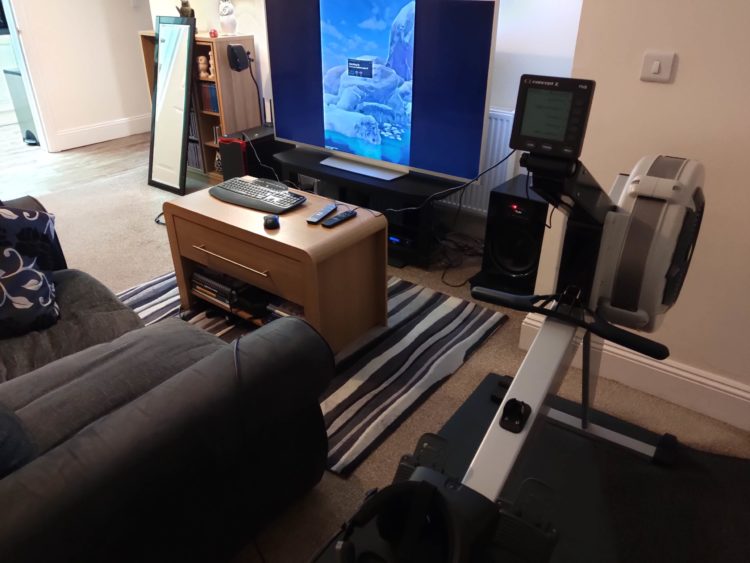
Article Update Note – Works well with Quest and Virtual desktop
It was suggested to me to try and see if the Quest could play the PC version wirelessly via Virtual Desktop. I gave it a try and can confirm it worked absolutely perfectly for me. I was able to complete a 5000-meter row around the Saturn environment and it was smoother, and looked much better, than the native Quest version. This is a huge plus for me as I hated using my Rift S for exercise. This will definitely be how I play from now on!
Sweatproof your headset
If you’re already familiar with exercising in VR then you’ll know that the problem of sweating into the headset can be easily mitigated with some simple preparation. However for those readers who may have a rowing machine but are less familiar with VR as an exercise tool, you might understandably assume that combining intense cardio workouts with an expensive electronic device strapped to your face could be a bad idea, so let me add some reassurance, as well as offer some practical advice.
Most VR headsets come with a removable facial interface that can be swapped out with an aftermarket solution that replaces the stock model for one made with a removable, wipeable material that can be easily cleaned off after use.
The most popular cover replacement company is VRCover and they provide high-quality aftermarket solutions for nearly all headsets, at an affordable price.
If you purchase one of these and wear a thin headband as additional protection your headset will be well protected. After use simply clean with alcohol-free wet wipes and leave to dry, and the headset will stay hygienic and sweat-free.
This is true for nearly all headsets, although the Rift S requires a little additional care, as its head strap design contains an awful lot of non-removable, sweat absorbing foam padding, to both the forehead and the base of the head areas. I’d suggest trying to keep this foam sweat-free as much as possible, and I’ve found that in addition to wearing a headband I can mitigate any excess sweat completely by wearing a thermal cycle skull cap. The one I have cost me £8 from Amazon and keeps all the sweat inside it, whilst being thin enough to not interfere with my headset comfort. I don’t bother wearing it with my Quest, but it’s great for the Rift S and I’d also recommend one if you’re using an expensive Valve Index too.
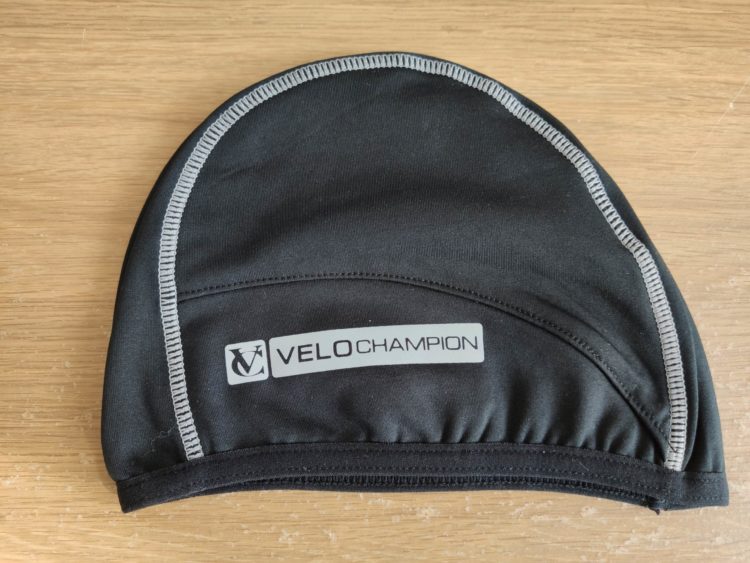
Interface, game mechanics and workout modes
Once set up the interface is very clean and easy to use. There is no controller input at all, all options are selected by gazing at the icons and holding for a couple of seconds until the circular timer completes its orbit and the action will select.
The app offers the following workout modes;
EXPLORE – Simply row through the environment of your choice without any time pressure. This is a great way to start off and just admire the scenery. Along the way, collectible trophies will appear that you can grab by staring at them. Most environments have 20 on the route and take around 4000 or so meters to row through and collect them all. If you complete a circuit it doesn’t end, you can go around again, and most environments have a branching pathway or two that you can select between during the journey, giving you something else to see the next time you visit that world.
TIME ATTACK – Here you can race against a ghost version of your previous best times over 2, 5, 10, 15, 20, or 30 minutes.
CARDIO GOALS – This is a neat mode. You can select from various predefined workouts, fat burn, cardio or HIIT. For example, a 15 minute HIIT workout will start you off gently to warm up then get you doing 30-second sprints with 90-second recovery intervals before repeating. You won’t want to train like this every day, but it’s great if you want to cycle between power, endurance, and recovery training over a period of weeks.
RACE MODE – This allows you to compete against computer AI riders, runners and rowers depending on the machine you are using. I’ve used my Quest to row a couple of 2000 meter races on Cambridge lake, and lining up alongside my rivals was a great experience. If you’re a serious athlete you can even row in a half marathon race of 13.1 miles.
MULTIPLAYER MODE – This allows up to 5 humans to join the same workout and train together. This will be great as the player base increases in size, or to use in a gym with several connected rowers.
This video shows the layout and function of the menu interface;
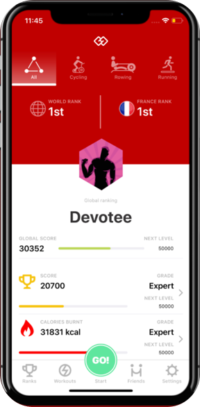
Handy mobile app
Both the PC and mobile versions of Holofit also come with a mobile app, from which you can launch workouts and view your stats and rankings. I really like this additional feature. It’s very professionally done, with a clean, crisp layout and provides additional motivation as you can see how much you’ve trained over the past week, month or year, etc, and where you rank on both the global and country leaderboards. It also shows you all the trophies you’ve collected so far.
GamePlay
The gameplay itself is very simple. Without a controller, there is no way to steer or interact with the environments beyond gazing to select which path to take. This makes sense when using a highly demanding piece of equipment like a rowing machine. Rowing requires your full attention, and the constant use of your hands and a high concentration to maintain the correct posture and stroke form. The additional interactivity of Virzoom’s VZFit would be unwelcome here, as leaning to steer and using a controller to engage in shooting or flying actions would feel very uncomfortable on a Concept 2 or WaterRower.
I’m interested to see whether it can sustain my interest in the same way on a bike, however. A bike is a much easier piece of equipment to use, only the lower half of your body is occupied and it’s easy, and in fact desirable for your mind to be elsewhere. I will reserve judgment until I’ve had a chance to review the bike riding on the Holofit but I’m not expecting it to deliver a comparable experience to the VZFit on a stationary bike, due to this lack of interactivity. Even if it isn’t as good however it won’t reflect badly on the product overall, as it’s clearly built around use with a rowing machine first and foremost, a machine the VZFit doesn’t support at all.
The Holofit simulates movement very well and I had no trouble convincing myself that I was truly propelling myself along, according to my own efforts. On both the Bluetooth and wired connection the PM5 transfers the correct pace, stroke rate, and wattage outputs to the Holofit, and you can see this information as you row.
Full body immersion
One feature I really love is that you have a complete body, each avatar, and boat purpose-built for each specific environment. Once you’ve found a steady, consistent pace your own strokes perfectly synchronize with your virtual rower’s arms. If you radically alter your pace, for example suddenly pulling much harder you can temporarily out-row your avatar’s arms but it will correct in time for the next stroke. I have actually long used a traditional flatscreen rowing program called Rowpro which does the same thing, and in fact, uses this as a teaching aid. It tells you to match your strokes to your virtual rower’s strokes to ensure a good, fluid stroke rate, and it feels the same here. If my real arms lose synchronicity with my virtual ones I know my strokes aren’t as fluid and consistent as they should be, and it focuses me to work on my form.
In use, the Holofit feels subtly different from Virzoom’s VZFit. Although superficially it looks like an alternative to VZFit’s Play app, the Holofit is definitely not a game, but rather a workout tool. Whilst the Holofit’s mechanics might lack in gamification they nonetheless provide a solid training platform thanks to the competitive racing, HIIT training, and the ability to challenge your own personal best times. This seems to reflect the two companies’ different target markets. Virzoom’s VZFit is marketed towards a more casual, gamer first focused consumer looking to exercise whilst having fun, whilst the Holodia team are adapting a VR application intended for commercial gym use and making it available to home VR users.
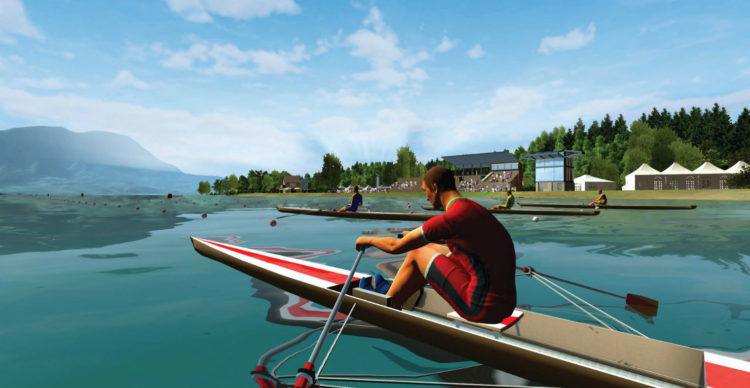
The environments are a feast for the eyes.
One standout feature of the Holofit app is the sheer beauty and variety of the landscapes themselves. The world locations are fantastic, richly detailed with lots of interesting events going on around you, and they mix up both real-world and fantastical settings.
You can take in a traditional row on Cambridge Lake, the boat moving backward as it should, so the environment recedes away from you. You’ll pass other rowers, and encounter various speed boats and pleasure cruisers all packed with people cheering you on.
If you prefer a more fantastical setting you can travel to space and row your way around Saturn, travel underwater, or even tour a dystopian Blade Runner-Esque cyberpunk city.

A lot of the fantasy worlds exist in both a vertical as well as a horizontal plane which gives them a wonderfully expansive feel. Your ears are not neglected either as the ambient sounds perfectly match whatever scene you’re in. Whether it’s the cacophonous squawking of startled flamingos, the menacing growl of a lone wolf stalking you from the riverbank, or the futuristic hums of flying cars and transporters there is so much going on that you will want to push on just to see what appears next.
On the Oculus Quest, all of this graphical detail does come at some cost, the framerate judders just a little in complex scenes, and the resolution is lowered to the point that pixelation is very noticeable in the distance. It’s certainly not a deal-breaker and I was perfectly happy with it until I tried it with my Rift S. On PC it’s absolutely beautiful, so much so I found myself wishing that there were actual games based on these worlds that I could play so that I could truly explore them.
I’ve taken some sample footage from both the Quest and the Rift S so that you can compare below. I’ve also uploaded much more to our Youtube channel so you can really get an idea for how Holofit looks and plays. As with all VR experiences, what you actually see inside the headset far surpasses what these little flat screen clips can provide. Be sure to turn up the audio to hear what a great sounding experience it is too!
Holofit in action – Oculus Quest
Given that few people are likely to have a Concept 2 rower conveniently laying next to their desktop PC (granted I’m the oddball exception who does) the most popular way to use the Holofit I imagine will be on the Oculus Quest.
I’ve put together a few small clips below so you can get an idea of how it looks and plays. Interestingly some of the environments are land-based and have you rowing some strange land rowing bicycle contraption. I’m no engineer but I have a hard time believing it would row forwards in real life but nonetheless I loved these levels, a nice break from water travel, hilariously good fun and they show off just how inventive the developers are.
Graphics on the Quest are decent, certainly more detailed than on VZFit Play, but at the cost of resolution and framerate at times. Still, the app works great, is easy to get up and running, and will be most users’ preferred option.
Two traditional landmark rowing venues feature amongst Holofit’s worlds, Cambridge lake, England and Lac d’Aiguebelette, France. Check out the beautiful relaxing waters of Aiguebelette in the video below.
If you’ve ever wanted to row on land, with the Holofit you can. Here’s footage I took racing through the streets of Paris.
Holofit in action – PCVR
As I said above when discussing setup, the PC based version, with its cables and QR code scanning takes longer to set up. But the payoff is worth it as you get some truly beautiful visuals.
Check out the snowy mountains level below to see the graphical upgrade over the Quest. It almost felt like I was in Skyrim, and I loved admiring the wildlife as I traveled through it. The ambiance is exceptional, a musical intro gradually fades to sounds of sheep bleating, and restless cattle mooing in the village before slowly giving way to river birdsong and later the howls of wolves as you venture into wilder territory.
The difference inside the headset is much more pronounced than the videos suggest. Everything is sharp, clear, and runs buttery smooth. Despite the extra setup time, and the fact I hate using my Rift S for exercise, this has become my preferred option, as the worlds are just beautiful to explore this way.
If you’re curious to see more footage we’ve uploaded several more videos and put them in a Holofit Playlist on our VRFitness Insider Youtube Channel for you to check out.
Concluding thoughts – Absolutely recommended for rowing enthusiasts wanting a virtual upgrade.
Although Holodia has been offering Holofit in gyms for a while, they are a relatively new arrival to the home VR fitness industry. I’m pleased to say they have really hit the ground running. The Holofit has done for my Concept 2 what VZFit has done for my stationary bike, and I can’t wait to try out its own bike mode too.
If playing Beat Saber and Thrill of the Fight has shown you VR’s potential for exercise and you’re now looking to get serious with your workouts then Holodia’s Holofit can unite the best traditional fitness cardio equipment to an extremely solid virtual reality experience.
It’s important to stress that unlike VZFit’s excellent Play app this isn’t an interactive gamified fitness experience, so don’t expect to be able to fly helicopters or hunt and shoot down enemy tanks. Rather it’s all about providing you with immersive environments in which to conduct your workout.
This is less game and more workout focused than the VZFit which suits the full-on intensity of the rowing machine perfectly. Once I’ve had an opportunity to test it I’ll also do a thorough hands-on of its bike mode too.
In supporting three types of cardio machine Holodia’s Holofit will prove increasingly useful the more equipment you have access to, and with such a long list of supported headsets, both PCVR and standalone, you can enjoy its continued compatibility even when you upgrade or change headsets.
It’s an absolute recommendation from me, and I will continue to use this as a major part of my weekly training regimen.
You can trial the PCVR version for free for 7 days on the Holodia website, and download a similar free trial on the Oculus Quest via Sidequest.

